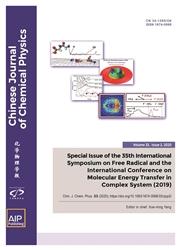A fitting program for structural determination of molecular clusters from rotational spectroscopy
IF 1.2
4区 化学
Q4 PHYSICS, ATOMIC, MOLECULAR & CHEMICAL
引用次数: 1
Abstract
The characterization of the structures of molecular clusters, which serve as building blocks for bulk substances, provides crucial insight into the interactions between constituent units. Chirped-pulse Fourier transform microwave (CP-FTMW) spectroscopy, combined with state-of-the-art quantum chemical calculations, is a powerful tool for characterizing the structures of molecular clusters, as the rotational spectra are directly related to the mass distribution of a molecule or cluster. However, determining the structures of large or complex clusters from experimental rotational spectra remains challenging due to their structural flexibility. Ab initio and density functional theory calculations for searching their stable structures could be significantly time-consuming and method-dependent. To address these challenges, we have developed an approach that relies on the experimental rotational constants to search for potential molecular structures without quantum chemical optimization. Our approach involves creating an initial set of conformers through either a semi-empirical sampling program or the quasi-Monte Carlo method. After-ward, the trust region reflective algorithm is utilized for structure fitting. This procedure enables us to quickly generate potential conformers and gain access to precise structural information. We apply our fitting program to water hexamer and benzaldehyde-water clusters, and the resulting topological structures align extremely well with the experimental results.用旋转光谱法测定分子团簇结构的拟合程序
作为大块物质的构建块的分子团簇的结构表征,为了解组成单元之间的相互作用提供了至关重要的见解。Chirped脉冲傅立叶变换微波(CP-FTMW)光谱与最先进的量子化学计算相结合,是表征分子团簇结构的强大工具,因为旋转光谱与分子或团簇的质量分布直接相关。然而,由于其结构的灵活性,从实验旋转光谱中确定大型或复杂团簇的结构仍然具有挑战性。从头算和密度泛函理论计算用于寻找它们的稳定结构可能非常耗时且依赖于方法。为了应对这些挑战,我们开发了一种方法,该方法依靠实验旋转常数来搜索潜在的分子结构,而无需量子化学优化。我们的方法包括通过半经验采样程序或准蒙特卡罗方法创建一组初始的构象。在ward之后,使用信任区域反射算法进行结构拟合。这一过程使我们能够快速生成潜在的构象异构体,并获得精确的结构信息。我们将拟合程序应用于水六聚体和苯甲醛水团簇,得到的拓扑结构与实验结果非常吻合。
本文章由计算机程序翻译,如有差异,请以英文原文为准。
求助全文
约1分钟内获得全文
求助全文
来源期刊

Chinese Journal of Chemical Physics
物理-物理:原子、分子和化学物理
CiteScore
1.90
自引率
10.00%
发文量
2763
审稿时长
3 months
期刊介绍:
Chinese Journal of Chemical Physics (CJCP) aims to bridge atomic and molecular level research in broad scope for disciplines in chemistry, physics, material science and life sciences, including the following:
Theoretical Methods, Algorithms, Statistical and Quantum Chemistry
Gas Phase Dynamics and Structure: Spectroscopy, Molecular Interactions, Scattering, Photochemistry
Condensed Phase Dynamics, Structure, and Thermodynamics: Spectroscopy, Reactions, and Relaxation Processes
Surfaces, Interfaces, Single Molecules, Materials and Nanosciences
Polymers, Biopolymers, and Complex Systems
Other related topics
 求助内容:
求助内容: 应助结果提醒方式:
应助结果提醒方式:


